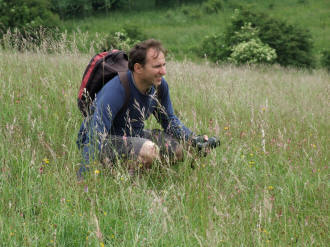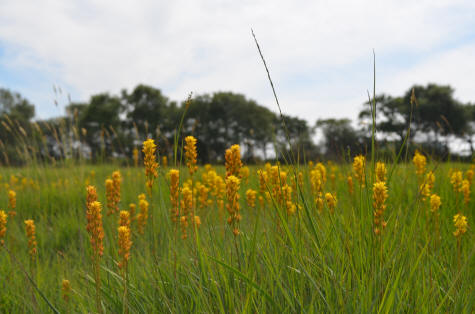Conservation - History in the making

Wild plants have suffered at our Greena Moor reserve, says Plantlife’s Reserves Manager Joe Costley. However, we all now have the chance to reverse their fortunes
Plantlife’s only Cornish nature reserve, Greena Moor, is located within a remote and sparsely-populated region known to geographers as The Culm. Nestled between the more celebrated areas of Dartmoor, Exmoor and Bodmin, this landscape and its inhabitants were vividly described by poet Ted Hughes in his Moortown Diary, and documented in exquisite photographs by James Ravilious. They describe a place of contrasts – there is the violence of nature, bleak winter scenes, rain-sodden fields and heavy toil. Yet there is also tenderness, genial characters and flowery meadows.

.jpg)
The Culm is typified by open expanses of plateaux farmland with sweeping views. It is a region of scattered hamlets connected by sunken lanes that snake beneath wind-sculpted hedgerows and many small but deep, wooded valleys. It is also distinguished by a characteristic suite of grassland habitats that are collectively known as Culm grassland. The high rainfall, carboniferous rocks and heavy clay soils have given rise to these delightfully scruffy and rather primaeval wet habitats where a fabulous diversity of herbs including saw-wort (Serratula tinctoria), meadow thistle (Cirsium dissectum), water mint (Mentha aquatica) and marsh violet (Viola palustris) grow among rushes and tussocks of purple moor-grass (Molinia caerulea).
Increasingly rare
Culm grassland has always had a restricted distribution, being confined to north Devon and north Cornwall, with similar grassland types found only in south Wales, south-west Scotland, north-west France and a few other places. Yet it is also increasingly rare; a staggering 92% has been lost in the past 100 years, with 48% disappearing between 1984 and 1991 alone. Greena Moor is one of the largest surviving fragments of Culm grassland in Cornwall. Yet even here, historical evidence from the Early Bronze Age indicates that the reserve is now only a fraction of what was once a much more extensive area of open, heathy downland, of uninterrupted flower-rich pasture.
It is only in relatively recent times (from the mid-19th century) that the moor was subdivided, and even more recently that much of the rough ground was tamed by modern agriculture. Wild plants have suffered but now we have an opportunity to bring about a change in their fortunes and to mark another turning point in the moor’s history. An amazingly generous response to a fundraising appeal, which Plantlife launched late last year, has allowed us to recently complete the purchase of a 46-acre extension to the original reserve, connecting two isolated areas of semi-natural habitat and taking the first steps to rebuild part of the more expansive Culm moor.
Wilder character
The extension to the reserve comprises three parcels, two of which are large fields that span the gap between isolated areas of Culm grassland. The fields have been agriculturally ‘improved’ and have a generally impoverished flora. However, one contains a substantial swathe of intact habitat with fen bedstraw (Galium uliginosum), gipsywort (Lycolus europaeus), wavy St John’s-wort (Hypericum undulatum) and tawny sedge (Carex hostiana) among others.
%20Trevor%20Dines.JPG)
The fields also retain a rushy, waterlogged character and species such as greater bird’s-foot trefoil (Lotus uliginosus), ragged-Robin (Lychnis flos-cuculi), lesser spearwort (Ranunculus flammula) and marsh ragwort (Senecio aquaticus) are present throughout, suggesting they ‘want’ a wilder character. Bringing back native plants to this commercial pasture will take time and will not be easy, but armed with experience from our Coronation Meadows project and a plentiful source of seed on the adjacent fields of the original reserve, we are well placed to make this work.
Acquisition of the extension also gives an impetus to address the reserve as a new, expanded whole, enabling rare species such as three-lobed crowfoot (Ranunculus tripartitus) to move beyond their existing ‘ghettos’, creating additional habitat for the threatened marsh fritillary butterfly and making improvements for our visitors to the site. A programme of activities is being compiled that will put these ideas into action. It includes plans for new infrastructure such as fencing, bridges, gates and visitor parking; habitat works including
grazing, scrub management and scrape creation; and also activities to engage volunteers and people from the local community.
These are exciting times at Greena Moor, and even more so because we are working to deliver this project in a partnership with Cornwall Wildlife Trust who own part of the original reserve.

Nowhere better
Earlier this year, I was lucky enough to spend time with our tenant farmer, Ron Harris, talking about Greena Moor, its past and its future. Ron is now in his seventies, and has lived and farmed at Greena Moor all his life. As he chatted, I was reminded of those James Ravilious photographs, and I marvelled at the levels of skill and connectedness with the moor that he must have achieved through decades of toil in all weathers.
In the fields ahead of us were stands of yellow bog asphodel (Narthecium ossifragum), the white flowers of heath-spotted orchids (Dactylorhiza maculata) and a mass of whorled caraway (Carum verticillatum) – and everywhere we looked, marbled white butterflies were tumbling past. Ron doesn’t take holidays, and it was clear the concept made no sense to him. It was as if he was stating the obvious when he said: “Why go anywhere else, there is nowhere better on earth than this.”
For more information on our nature reserves visit www.plantlife.org.uk/uk/nature-reserves-important-plant-areas/nature-reserves
Reader offer: Join Plantlife
As part of the partnership, Plantlife is offering a 50% to any CJS reader who would like to join Plantlife for the first time. Visit http://shop.plantlife.org.uk/collections/membership and choose Individual, Joint or Family membership. When you reach the checkout,
just enter the discount code CJS.